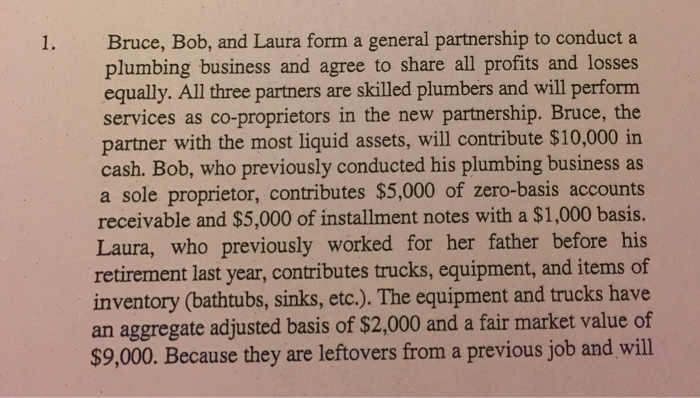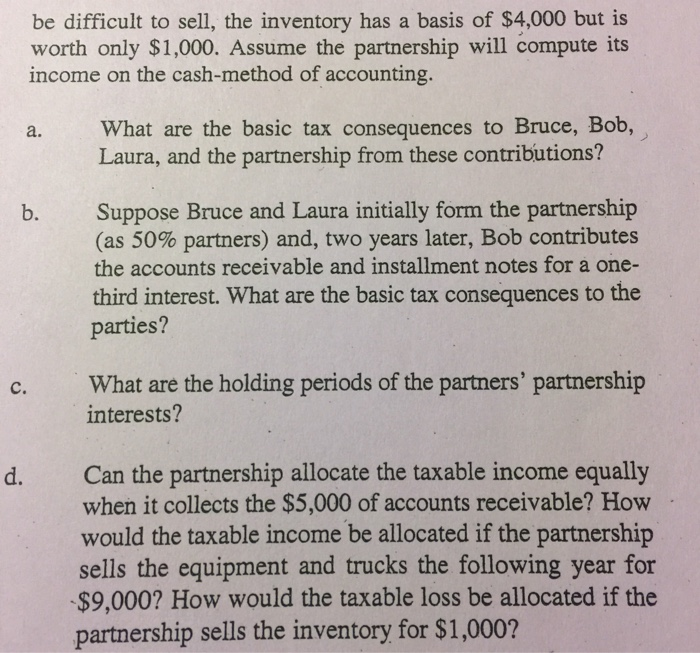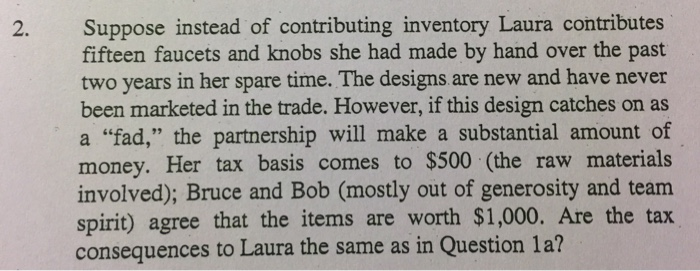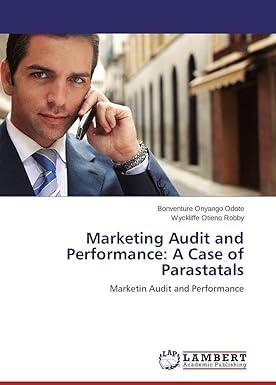Bruce, Bob, and Laura form a general partnership to conduct a plumbing business and agree to share all profits and losses equally. All three partners are skilled plumbers and will perform services as co-proprietors in the new partnership. Bruce, the partner with the most liquid assets, will contribute $10,000 in cash. Bob, who previously conducted his plumbing business as a sole proprietor, contributes $5,000 of zero-basis accounts receivable and $5,000 of installment notes with a $1,000 basis. Laura, who previously worked for her father before his retirement last year, contributes trucks, equipment, and items of inventory (bathtubs, sinks, etc.). The equipment and trucks have an aggregate adjusted basis of $2,000 and a fair market value of $9,000. Because they are leftovers from a previous job and will 1. be difficult to sell, the inventory has a basis of $4,000 but is worth only $1,000. Assume the partnership will compute its income on the cash-method of accounting. a. What are the basic tax consequences to Bruce, Bob, Laura, and the partnership from these contributions? Suppose Bruce and Laura initially form the partnership (as 50% partners) and, two years later, Bob contributes the accounts receivable and installment notes for a one- third interest. What are the basic tax consequences to the b. parties? c. What are the holding periods of the partners' partnership interests? d. Can the partnership allocate the taxable income equally when it collects the $5,000 of accounts receivable? How would the taxable income be allocated if the partnership sells the equipment and trucks the following year for $9,000? How would the taxable loss be allocated if the partnership sells the inventory for $1,000? 2. Suppose instead of contributing inventory Laura contributes fifteen faucets and knobs she had made by hand over the past two years in her spare time. The designs are new and have never been marketed in the trade. However, if this design catches on as a "fad," the partnership will make a substantial amount of money. Her tax basis comes to $500 (the raw materials involved); Bruce and Bob (mostly out of generosity and team spirit) agree that the items are worth $1,000. Are the tax consequences to Laura the same as in Question 1a? Suppose instead of contributing inventory, Laura contributes a letter of commitment to perform all of the plumbing work in a 3. proposed shopping center. Laura handled all the negotiations for two years while working for her father before the commitment finally came through. Unfortunately, the commitment grants the contract to the father's business and does not say whether a business without Laura's father could be appointed to do the job. This letter (along with all the other assets) was given to Laura when her father retired. Laura's basis in the letter is zero; Bruce, Bob, and Laura agree that its fair market value equals $1,000. Are the tax consequences to Laura the same as in Question 2? 4. What different consequences result in Question 1a if Laura's equipment and trucks are encumbered with a $9,000 recourse liability that the partnership assumes a. Suppose Laura's basis in the inventory was $2,000 instead of $4,000. What are the tax consequences to Laura upon the formation of the partnership? Bruce, Bob, and Laura form a general partnership to conduct a plumbing business and agree to share all profits and losses equally. All three partners are skilled plumbers and will perform services as co-proprietors in the new partnership. Bruce, the partner with the most liquid assets, will contribute $10,000 in cash. Bob, who previously conducted his plumbing business as a sole proprietor, contributes $5,000 of zero-basis accounts receivable and $5,000 of installment notes with a $1,000 basis. Laura, who previously worked for her father before his retirement last year, contributes trucks, equipment, and items of inventory (bathtubs, sinks, etc.). The equipment and trucks have an aggregate adjusted basis of $2,000 and a fair market value of $9,000. Because they are leftovers from a previous job and will 1. be difficult to sell, the inventory has a basis of $4,000 but is worth only $1,000. Assume the partnership will compute its income on the cash-method of accounting. a. What are the basic tax consequences to Bruce, Bob, Laura, and the partnership from these contributions? Suppose Bruce and Laura initially form the partnership (as 50% partners) and, two years later, Bob contributes the accounts receivable and installment notes for a one- third interest. What are the basic tax consequences to the b. parties? c. What are the holding periods of the partners' partnership interests? d. Can the partnership allocate the taxable income equally when it collects the $5,000 of accounts receivable? How would the taxable income be allocated if the partnership sells the equipment and trucks the following year for $9,000? How would the taxable loss be allocated if the partnership sells the inventory for $1,000? 2. Suppose instead of contributing inventory Laura contributes fifteen faucets and knobs she had made by hand over the past two years in her spare time. The designs are new and have never been marketed in the trade. However, if this design catches on as a "fad," the partnership will make a substantial amount of money. Her tax basis comes to $500 (the raw materials involved); Bruce and Bob (mostly out of generosity and team spirit) agree that the items are worth $1,000. Are the tax consequences to Laura the same as in Question 1a? Suppose instead of contributing inventory, Laura contributes a letter of commitment to perform all of the plumbing work in a 3. proposed shopping center. Laura handled all the negotiations for two years while working for her father before the commitment finally came through. Unfortunately, the commitment grants the contract to the father's business and does not say whether a business without Laura's father could be appointed to do the job. This letter (along with all the other assets) was given to Laura when her father retired. Laura's basis in the letter is zero; Bruce, Bob, and Laura agree that its fair market value equals $1,000. Are the tax consequences to Laura the same as in Question 2? 4. What different consequences result in Question 1a if Laura's equipment and trucks are encumbered with a $9,000 recourse liability that the partnership assumes a. Suppose Laura's basis in the inventory was $2,000 instead of $4,000. What are the tax consequences to Laura upon the formation of the partnership












